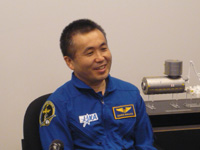JAXA Astronaut Activity Report, May, 2014
Last Updated: July 9, 2014
This is JAXA’s Japanese astronaut activity report for May, 2014.
Astronaut Koichi Wakata returns to Earth; successfully accomplishing his ISS long-duration mission

Wakata talks on a satellite phone just after landing (Credit: JAXA/NASA/Bill Ingalls)
On May 14, astronaut Koichi Wakata returned to Earth, accomplishing his 188-day ISS long-duration expedition 38/39 mission aboard the International Space Station (ISS).
During the mission, Wakata worked on various activities, mostly for scientific experiments utilizing the Japanese Experiment Module, “Kibo” and collecting his own medical data for medical experiments.In addition, he serviced system maintenance operations, including experimental equipment.
Wakata assumed command of the station’s Expedition 39, coordinated crew tasks and devoted himself to ensuring the safety of ISS operations; valuing communication between his crewmates and ground controllers. During his command, a failure occurred in the exterior hardware. However, under his direction, the onboard crew and relevant ground staff tackled and resolved the problem without it developing into a major issue.
On May 14, Wakata and his crewmates: Russian cosmonaut Mikhail Tyurin and NASA astronaut Richard Mastracchio departed the ISS at 7:36 a.m. aboard the Soyuz TMA-11M (37S) spacecraft. A few hours later, de-orbit burn occurred followed by entry interfaces to the atmosphere. Finally, at 10:58 a.m., they landed in the steppe of Kazakhstan.For his return, astronaut Akihiko Hoshide came to the touchdown point and supported Wakata; cooperating with the JAXA flight surgeon and Russian and NASA officials.

Wakata speaking to the press (Credit: JAXA)
The same day, Wakata left Kazakhstan for medical checkups and to undergo rehabilitation at the NASA Johnson Space Center (JSC) and arrived at Houston, Texas, U.S., the next day.
At the first press conference after his return, which was held on May 28, Wakata appeared healthy to the press at the JSC. During the Q&A session, Wakata stated his current status and mission results, and expressed his future aspirations.
Astronaut Kimiya Yui’s training in Germany and Russia for a long-duration ISS mission
Astronaut Kimiya Yui, assigned as a crew member for the Expedition 44/45 mission to the International Space Station (ISS), underwent training for a long-duration mission at the European Astronaut Centre (EAC) of the European Space Agency (ESA) in Cologne, Germany between May 7-14, and then at the Gagarin Cosmonaut Training Center (GCTC) from May 19.
In Germany, Yui attended lectures and trained using the full-scale training facility to acquire the knowledge required to operate the hardware onboard the Columbus laboratory module.
During the training, he learned about the system hardware that controls thermal and electrical power and its safety treatment. In addition, Yui also confirmed the operations and maintenance of each of the experiment racks, including the Biolab, Fluid Science Laboratory (FSL), and European Physiology Modules (EPM).
In Russia, he conducted training for the ISS Russian segment and Soyuz spacecraft. As part of the ISS Russian segment, he attended lectures on the Russian communications systems and the Electrical Power System as well as responses to emergencies such as fire and sudden depressurization. Regarding the Soyuz spacecraft, via a simulator, Yui simulated manual operations from orbit insertion to ISS approach, final approach and docking, and reentering the atmosphere after Soyuz had undocked from the ISS.
Astronaut Takuya Onishi’s training at the JSC for a long-duration ISS mission
Astronaut Takuya Onishi, who was assigned as a crew member for the Expedition 48/49 mission to the International Space Station (ISS), underwent training for the ISS system hardware at the NASA Johnson Space Center (JSC).
As part of the Thermal Control System (TCS) training, Onishi learned the operations of the Internal Thermal Control System (ITCS) that collects excess heat from the pressurized section and the External Thermal Control System (ETCS), which discharges excess accumulated heat externally.
As part of the failure response simulation, he also confirmed how to respond to any refrigerant circulation stoppage.
Regarding the ISS Environmental Control and Life Support System (ECLSS) training, he confirmed the operations of the system used to recover water and air. He also practiced removing and installing the system and experiment equipment and how to open and close hatches between ISS modules.
Onishi continued flight training using a T-38 jet trainer as part of his space flight preparation.


